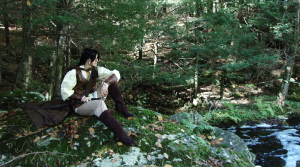The film project is currently on its one and only two-week break from photography. Each of us are using this time for different project-related matters: Jen and I have worked on some new costume material, my brother is continuing work with his fight team, Jack is attending a film-fest (which includes an animated film he created), and I am fine-tuning the script and going over lines with actors who have yet to appear onscreen. In general news, a Facebook fan page has been created for the film, which quickly rocketed to 33 members. I’ve never met at least 25 of them. So much for keeping this project under wraps (story specifics and the cast are still in large part secret, however).
I want to take a moment to talk about the whole “art” process behind this film. I included a quote from Tolkien last time in which he expressed the desire to see his work interpreted by other minds in the form of paint, music and drama. I’ll say a bit about music in a future entry, as we’re having original music composed for the film, while taking this time to look at the visual aspect of things.
Jen’s background in cosplay and costume-craft is one of the saving graces of our project (whether or not she’d blush to hear/read that). However, it’s not a situation where I (as director) say “Here’s someone I know who is good at making costumes – go crazy!” It’s been a very collaborative process with a high level of communication – I even took scissors to fabric a few times myself. We’ve been greatly concerned with color, contrast with scenery (forests, lakes, whitewater, wooden walls, concrete fountains, the sun’s reflection on rock, etc) and other parts of a costume (including wigs – currently, six cast members are wearing wigs in the film). The ideas behind these costumes come greatly from what we know of the characters. Quite often, Tolkien goes into great detail about appearance, yet sometimes none at all. How exact do we want the costumes to be? We came to the conclusion that we need to do what is right for the characters we’re dealing with based on the above factors, as well as what we draw from a character’s personality, while keeping the outfits described in-text within the ballpark. There’s also a budget to consider, so “a thousand studs of crystal” (from Tolkien’s description of Ecthelion’s shield in Unfinished Tales) may become three or four, or no shield at all if the scene doesn’t call for him to be holding one.
The visual imagery doesn’t end with creating interesting (or accurate) costumes. For decades, the works of Tolkien have been interpreted into paint and other visual art by everyone from renowned artists such as John Howe and Ted Nasmith to internet painters who still go unnamed and unknown. While working on my own adaptation, I’ve been considering some of my favorite Tolkien art and allowing it to inspire ideas and landscapes in my own work. Take a look at this.

The meeting of Tuor and Ulmo is a relatively iconic moment in Tolkien’s mythology. It’s clearly described: Ulmo is in the water, Tuor is on shore. In some versions he kneels, in some he doesn’t. I couldn’t make Ulmo forty feet tall in my adaptation, but I’m not sure I would have wanted to. Ulmo convinces Tuor to take on a burden through words, not through intimidation. It serves a film better to have the scene portrayed as two people talking face to face, even if one has a booming voice and infinite power. Howe’s artwork was one of the main forces behind my ideas for the scene, though I didn’t try to emulate it, per se; Howe’s painting made me feel this scene, and drove me to evoke a similar feeling in my own work. Unlike Howe, I cannot use one image; I need costumes, camera angles, music, sound, movement and dialogue.

Oddly enough, we created Voronwë’s costume and filmed this scene long before coming across Marya’s artwork (on the internet), so the resulting effect was the opposite. This being a very clearly described image in the text, it’s easy to see why it would be depicted in a similar way, but these similarities blew me away. Note the position of V’s left knee and elbow above, then look at Jen’s in our picture. Chilling.
We are doing visual imagery that is our own, fitting with the directing style/art direction of the film and following a set of image patterns put forth by the specific story material we’re tackling, but with some truly interesting parallels with artwork that is now considered “classic” within the Tolkien realm, as well as concurring with relatively younger fans’ ideas of what these scenes may look like. There is no clearly-defined balance; most of it is happening almost subconsciously.
I’m enjoying this journey a lot.
—By Richard Hartshorn
